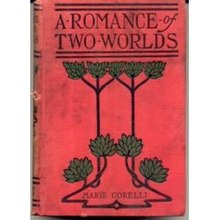A Romance of Two Worlds
 |
|
| Author | Marie Corelli |
|---|---|
| Language | English |
| Publisher | Bentley |
|
Publication date
|
1886 |
| Media type | hardback, paperback |
| Followed by | Ardath |
A Romance of Two Worlds was Marie Corelli's first novel, published in 1886. It referenced the contemporary debate between creationism and evolution, as well as supernatural themes, overlaid with elements of science fiction. The book was an immediate success, well beyond expectations.
A Romance of Two Worlds starts with a young heroine, in first person, telling her story of a debilitating illness that includes depression and thoughts of suicide. Her doctor is unable to help her and sends her off on a holiday where she meets a mystical character by the name of Raffello Cellini, a famous Italian artist. Cellini offers her a strange potion which immediately puts her into a tranquil slumber, in which she experiences divine visions. Upon wakening, she craves more. Later, she meets her unnamed guardian angel, who whisks her through infinite solar systems faster than a shooting star while human spirits fly by like gossamer silk. He shares the truth of religion and the secret of human destiny, but still she longs for more. She comes to understand God as pure light and pure love, but it's not enough that she should see and hear these things from the touch of an angel. She wants to master this ability on her own and seeks a oneness with God through a series of meditative disciplines while locked away in a monastery.
The novel was rejected for publication by Hall Caine—an act that began a lifelong feud between Caine and Corelli. After hearing of Caine's harsh criticism, George Bentley suspected that the novel might have commercial appeal and published Corelli's first novel.
Marie Corelli did not expect A Romance of Two Worlds to be so well received. She claims, in the introduction to the second printing in 1887, that, "It was not only read, but loved."
Her scripture, "The Electric Principle of Christianity," included in the novel, is presented as something factual and after the publication of the book, generated a cult following, in which readers sought more information about her experience. Today, New Age devotees hail Corelli as "inspired". Many believe that the book is autobiographical, a belief which Corelli encouraged. In several chapters Corelli hints that Heliobas may be the Count of St. Germain, although Rosicrucian authors identify him as an Illuminati hierophant, Count A. di Guinotti Heliobas appears in two other Corelli novels, Ardath and The Soul of Lilith.
...
Wikipedia
